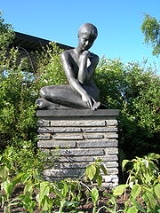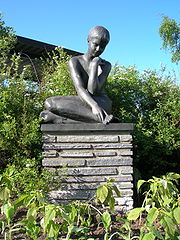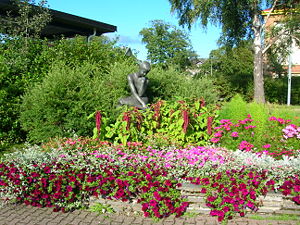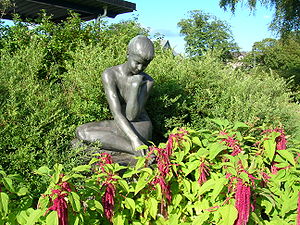
Rana Niejta
Encyclopedia

Ume Sami
Ume Sami is a Sami language spoken in Sweden and Norway. It is a dying language with only about 10 native speakers left and is spoken mainly along the Ume River in the north of Arjeplog and Arvidsjaur.- Consonant gradation :...
names on a goddess in sami mythology
Sami religion
Sámi shamanism is a Sámi neo-shamanistic or neo-paganistic religion. Though it varied considerably from region to region within Sápmi, it commonly emphasized ancestor worship and animal spirits, such as the bear cult...
. In Northern Sami
Northern Sami
Northern or North Sami is the most widely spoken of all Sami languages. The speaking area of Northern Sami covers the northern parts of Norway, Sweden and Finland...
she is called Rana Neida and Rana Neide (names in other Sami languages are Rana Nieda, Ruona Neida, Radien-neide and Blende).
Rana Niejta is the goddess for spring and fertility. The literal translation of the name Rana is «the green» or «the green, fertile fields». The name Rana Niejta can freely be translated as «the daughter of earth». According to Sami mythology, she made the mountains turned southwards green, so that hungry reindeer had enough food.
Sala Niejta and Rana Niejta
The Finnish linguist Otto DonnerOtto Donner
Otto Donner was a Finnish linguist and politician. He was professor of Sanskrit and Comparative Indo-European linguistics at the University of Helsinki, but also studied the Finno-Ugric languages. He was a member of the Finnish parliament 1877–1905, and minister of education 1905–1908...
described in his translation of sami poems into German
German language
German is a West Germanic language, related to and classified alongside English and Dutch. With an estimated 90 – 98 million native speakers, German is one of the world's major languages and is the most widely-spoken first language in the European Union....
and Finnish
Finnish language
Finnish is the language spoken by the majority of the population in Finland Primarily for use by restaurant menus and by ethnic Finns outside Finland. It is one of the two official languages of Finland and an official minority language in Sweden. In Sweden, both standard Finnish and Meänkieli, a...
in 1876, how Sala Niejta (the daughter of the Sun), Rana Niejta and Saivo Niejta (the daughter of underworld) often were mentioned together in sami poetry, and sometimes were confused with each other by outsiders without personal knowledge of sami mythology:
However, older sources from 1700 clearly shows that they are three different goddesses. Sala Niejta had the power to make an end on the snow and the cold, while Rana Niejta made it possible for threes and herbs to grow and flourish anew every year. Rana Niejta thus represents the recreation of the spring.
The Samis considered the Sun as
Sala Niejta and Rana Niejta were two different goddesses, which, together with
The place of Rana Niejta in Sami mythology
Among the Swedish samis, Rana Niejta was considered as the daughter of the highest god Radien-attje and his wife Radien-akka.On the southern sami drums, Radien-attje is most often placed on the uppermost part, with Radien-akka and the son Radien-pardne on each of his sides. Some Swedish sami drums also shows Rana Niejta as the daughter of the highest god.
Sami shamans sometimes turned a spin wheel covered with blood towards her altar as an act of sacrifice for an early spring. Rana Niejta might correspond to the goddess Freyja in norse mythology
Norse mythology
Norse mythology, a subset of Germanic mythology, is the overall term for the myths, legends and beliefs about supernatural beings of Norse pagans. It flourished prior to the Christianization of Scandinavia, during the Early Middle Ages, and passed into Nordic folklore, with some aspects surviving...
.
The municipality of Rana, Norway
Some also consider her name as the origin of the name of the municipality of RanaRana, Norway
Rana is the second largest municipality in Nordland county – and the third largest in North Norway – by population. By area, Rana is largest in Norway south of Finnmark , taking in large areas of mountains and forested valleys. It is part of the Helgeland traditional region...
in Norway
Norway
Norway , officially the Kingdom of Norway, is a Nordic unitary constitutional monarchy whose territory comprises the western portion of the Scandinavian Peninsula, Jan Mayen, and the Arctic archipelago of Svalbard and Bouvet Island. Norway has a total area of and a population of about 4.9 million...
.
In 1971, a bronze statue depicting Rana-Niejta was raised in the park beneath the shopping centre LA Meyer in Mo i Rana
Mo i Rana
Mo i Rana is a town in the municipality of Rana, Nordland, Norway, located just south of the Arctic Circle and in the region Helgeland. The town is called "Mo i Rana" to distinquish it from other places named Mo - most notably the town of Mosjøen, also in Helgeland - though locally the town is...
. The statue was made by the artist Arne Durban, and financed by Den Norske Bank (DNB, «The Norwegian Bank») in 1970 in connection with its 25-years anniversary. It was delivered to Rana municipality on November 19, 1970. In 2003, a similar statue was moved from DNB to Nordlandsbanken («Bank of Nordland») in Rana after the process of amalgamating the two banks.


Literature
- [Sckanke NS-2] Hans Sckanke: Epitomes Historiae Missionis Lapponica. Pars Prima. Anlagende de Norske Lappers Hedendom og Superstitioner, utgitt av Martha Brock Utne og O. Solberg i Finnmark omkring 1700. Aktstykker og oversikter, Nordnorske Samlinger, Etnografisk museum, Universitet i OsloOsloOslo is a municipality, as well as the capital and most populous city in Norway. As a municipality , it was established on 1 January 1838. Founded around 1048 by King Harald III of Norway, the city was largely destroyed by fire in 1624. The city was moved under the reign of Denmark–Norway's King...
, A.W. Brøggers boktrykkeri, 1938, bind 2, pp. 175–256 - [Donner, 1876] Otto Donner: Lieder der Lappen − Lappalaisia lauluja, Suomi-kirjan Toinen Jakso, II Osa, HelsinkiHelsinkiHelsinki is the capital and largest city in Finland. It is in the region of Uusimaa, located in southern Finland, on the shore of the Gulf of Finland, an arm of the Baltic Sea. The population of the city of Helsinki is , making it by far the most populous municipality in Finland. Helsinki is...
, 1876 - Bo Lundmark: Bæi'vi mánno nástit (Ume SamiUme SamiUme Sami is a Sami language spoken in Sweden and Norway. It is a dying language with only about 10 native speakers left and is spoken mainly along the Ume River in the north of Arjeplog and Arvidsjaur.- Consonant gradation :...
) = Sol- och månkult samt astrala och celesta föreställningar bland samerna (SwedishSwedish languageSwedish is a North Germanic language, spoken by approximately 10 million people, predominantly in Sweden and parts of Finland, especially along its coast and on the Åland islands. It is largely mutually intelligible with Norwegian and Danish...
) [The Sun and the Moon cult and Celestial and Astral concepts among the Saamis]), Acta Bothniensia Occidentalis, Skrifter i västerbottnisk kulturhistoria, UmeåUmeå- Transport :The road infrastructure in Umeå is well-developed, with two European highways passing through the city. About 4 km from the city centre is the Umeå City Airport...
, Västerbottens museum, 1982

